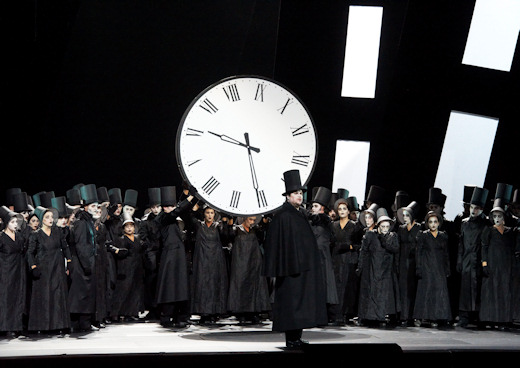Other Links
Editorial Board
- UK Editors
- Roger Jones and John Quinn
Editors for The Americas - Bruce Hodges and Jonathan Spencer Jones
European Editors - Bettina Mara and Jens F Laurson
Consulting Editor - Bill Kenny
Assistant Webmaster -Stan Metzger
Founder - Len Mullenger
Google Site Search
SEEN AND HEARD INTERNATIONAL OPERA REVIEW
Hindemith, Cardillac: Soloists, Orchestra and Chorus of the Vienna State Opera. Conductor: Franz Welser-M�st. 17.10.2010 (SM)
Production:
Franz Welser-M�t, Conductor
Sven-Eric Bechtolf, Stage Director
Rolf Glittenberg, Set Design
Marianne Glittenberg, Costume Design
J�rgen Hoffmann, Lighting
Thomas Lang, Chorus master
Cast:
Juha Uusitalo, Cardillac
Juliane Banse, his Daughter
Herbert Lipper, the Officer
Tomasz Konieczny, the Gold Merchant
Matthias Klink, the Cavalier
Ildiko Raimondi, the Lady
Alexandru Moisiuc, the Provost-Marshal

Juha Uusitalo as Cardillac
Hindemith's "Cardillac" isn't the most obvious choice to begin a directorship at the Vienna State Opera. The 90-minute three-acter, composed in 1926, is unfamiliar even to German-speaking audiences and, while firmly rooted in the "Neue Sachlichkeit" of the 1920s, contains no toe-tapping, jazz-inspired melodies you can hum along to after the show.
But Dominique Meyer, the 55-year-old Frenchman who took over from Ioan Holender as head of the Vienna State Opera at the beginning of September, has rather tellingly picked this dark little score as the first new fully-staged production under his leadership. Hindemith's "New Objectivity" was a direct reaction against the heady late romanticism of Wagner and Co. By contrast, Holender began and ended his 18-year reign on Vienna's world-famous Ringstrasse with "Parsifal".
In an interview published in the programme, the house's new GMD Franz Welser-M�st points out that "Cardillac" contains arias in the baroque concerto-grosso style familar from Bach's or Telemann's cantatas. And in contrast to Wagner's "endless melos", it marks a return to a number opera and even has small recitatives,
Welser-M�st notes. But Meyer, who seems to be as unassuming as his Romanian-born predecessor was loud and garish, is not intent on turning the Staatsoper upside down and eradicating all traces of Holender, who was the house's longest-serving director. Rather, befitting the soft-spoken, besuited Frenchman that he is, who addresses his staff as "Kinder" (or "children"), Meyer seems keen for his revolution to be a quiet one, building on the bricks that Holender left behind, rather than knocking the edifice down and starting from scratch.
The leading team for "Cardillac", for example, is the same for Holender's last "Ring", with
Welser-M�st in the pit, German actor and director Sven-Eric Bechtolf responsible for the staging and sets and costumes designed by Bechtolf's collaborators Rolf and Marianne Glittenberg.
Even two of the cast from the "Ring" - Finnish baritone Juha Uusitalo who sang Wotan and Polish bass-baritone Tomasz Konieczny who sang Alberich
- have been lined up for "Cardillac", with the former taking the title role and the latter appearing as the Gold Merchant. It's an astute and very clever sleight of hand on Meyer�s part.
While Bechtolf's "Ring" was understated to the point of being bland, the German director and his team clearly revel in the concentration and acerbity of Hindemith's underrated score. Glittenberg's sets, all expressionist black and white, are reminiscent of F. W. Murnau's 1922 film masterpiece, "Nosferatu", while his partner's costumes could have come straight from a Tim Burton movie.
Interestingly, while "Cardillac" is barely known outside of German-speaking opera houses, this is the fourth staging in Vienna since 1927, with the last one dating from 1994. And if an illustration from the programme is to be believed, Glittenberg appears to quote from the original 1927 production in the second scene where the Lady's bedroom is a stunning backdrop of a single red curtain.
Bechtolf is clearly at home in this dark tale - based on a novella by the German romantic poet E.T.A. Hoffmann (1776-1822)
- of a master goldsmith who murders anyone who buys his jewellery because he cannot bear to part with it. Cardillac is a lonely, embittered artist, who loves the jewellery he makes more than the people around him, including his own daughter. Gold and how it can rob people of human love and warmth is, surely, also a link back to Wagner's "Ring". For all its cartoonish, wood-cut visuals, Bechtolf's treatment turns the monster Cardillac into a psychologically credible figure: a man who murders because of his inability to cope with human relations. With his imposing baritone, Uusitalo lends an almost human face to the goldsmith at times.
Despite - or because of - the jerky, doll-like movements that Bechtolf assigns her, German soprano Juliane Banse was perhaps even more affecting as Cardillac's Daughter, poignantly seeking, but ultimately failing, to win the father's love she so craves. As the Officer who offers to take her away from it all, Austrian tenor Herbert Lippert had clearly brought his own fan-club with him for opening night, who feted him like a pop star, even if his voice tended to sound thin and nasal. As the Gold Merchant, Konieczny appeared to want to revisit his role as Alberich from Wagner's "Ring". The smaller parts were ably taken by German tenor Matthias Klink as the Cavalier and Romanian soprano Ildiko Raimondi as the Lady.
Cast, conductor and director all received rapturous applause from the first-night audience, with Bechtolf and Welser-M�st receiving the warmest reception. "Cardillac"
is being given an initial run of five performances until October 30th
But Meyer's next little revolution already comes next month with another first: a new production of "Alcina" under Marc Minkowski and his amazing period-instrument band, Les Musiciens du Louvre-Grenoble. Baroque opera was banned from Vienna under Holender and it will be the first time that the house orchestra, made up of members of the Vienna Philharmonic, is to be replaced by a guest ensemble.
Vive la Revolution!
Simon Morgan
Production Picture � Wiener Staatsoper/Michael P�hn
